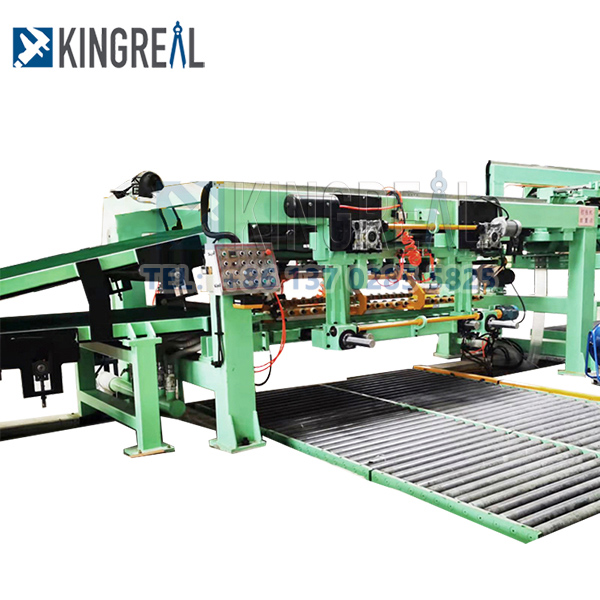Mastering the Art of Precision: Overcoming Challenges in Leveling Stainless Steel with Precision Levelers
2023-12-08
Introduction:
In the world of stainless steel manufacturing, the quest for perfection is often met with unique challenges. The process of leveling stainless steel sheets demands precision, addressing inherent complexities to ensure flatness and consistency. Enter the Precision Leveler—a technological marvel designed to tackle the hurdles that come with leveling stainless steel. In this blog, we'll unravel the common challenges associated with leveling stainless steel and explore how the Precision Leveler skillfully addresses them, paving the way for flawless sheets.
Stainless Steel Challenges: A Closer Look
1. Residual Stresses:
Stainless steel sheets can carry residual stresses originating from the manufacturing processes. These stresses, if not properly addressed, can lead to deformations and compromises in material integrity. Precision Levelers are equipped with advanced roller configurations and adjustable pressure mechanisms to effectively mitigate and eliminate these residual stresses, ensuring a stress-free and durable end product.
2. Material Hardness:
Stainless steel is known for its hardness, which poses challenges during the leveling process. The hardness of the material demands a careful and controlled approach to prevent excessive wear on the leveling rollers and potential damage to the material. Precision Levelers are designed with roller configurations and hardness considerations that strike the right balance, providing the necessary pressure without compromising the equipment or the stainless steel's structural integrity.
3. Variability in Thickness and Grades:
Stainless steel sheets come in various thicknesses and grades, each with its own set of challenges. Precision Levelers must contend with this variability, requiring flexibility to handle thin gauges as well as thicker sheets. Variable speed control and adjustable roller settings allow Precision Levelers to seamlessly adapt to different thicknesses and grades, ensuring consistent flatness across a diverse range of materials.
4. Surface Imperfections:
Surface imperfections in stainless steel, such as scratches or dents, pose challenges during the leveling process. Precision Levelers are equipped with advanced monitoring systems that can detect surface irregularities in real-time. Automated adjustments based on this feedback enable the leveler to compensate for imperfections, resulting in a smooth and aesthetically pleasing surface finish.
5. Temperature Sensitivity:
Stainless steel's response to temperature fluctuations can impact the leveling process. Precision Levelers may incorporate temperature control mechanisms to maintain optimal operating conditions. This is particularly crucial in environments where temperature variations could affect the material's properties, ensuring that the leveling process is consistently effective.
6. Edge Waves and Center Buckles:
Edge waves and center buckles are common challenges associated with leveling stainless steel sheets. Precision Levelers address these issues by employing segmented rollers and other innovative roller configurations. These configurations allow the leveler to exert precise pressure at different points on the sheet, correcting edge waves and center buckles and achieving uniform flatness.
Precision Leveler: A Solutions Provider
1. Automated Adjustments:
Precision Levelers are equipped with advanced automation and control systems that enable automated adjustments in real-time. These adjustments are based on continuous monitoring of key parameters, allowing the leveler to adapt to variations in the stainless steel sheets and maintain optimal leveling conditions throughout the process.
2. Versatility in Roller Configurations:
The roller configurations of Precision Levelers are designed for versatility. Segmented rollers, adjustable roller spacings, and other innovations provide flexibility to address different challenges associated with leveling stainless steel. This versatility allows the Precision Leveler to effectively correct various imperfections and ensure uniform flatness.
3. Variable Speed Control:
Variable speed control is a crucial feature of Precision Levelers. The ability to adjust the processing speed based on the thickness and grade of the stainless steel sheets allows for a tailored approach to leveling. This feature ensures that the leveler maintains the delicate balance between precision and efficiency.
4. Enhanced Monitoring Systems:
Precision Levelers incorporate advanced monitoring systems that continuously track key parameters such as flatness, thickness, and surface quality. This real-time feedback loop enables the leveler to make instantaneous adjustments, addressing challenges as they arise and ensuring the production of high-quality stainless steel sheets.
Conclusion:
The challenges associated with leveling stainless steel are met head-on by the Precision Leveler, a technological marvel that brings precision, adaptability, and automation to the process. By addressing residual stresses, hardness considerations, surface imperfections, and other hurdles, Precision Levelers play a crucial role in shaping stainless steel sheets that meet the highest standards of quality and performance. As stainless steel continues to be a cornerstone in various industries, the Precision Leveler stands as a key enabler, unlocking the potential for flawless and resilient stainless steel products.



